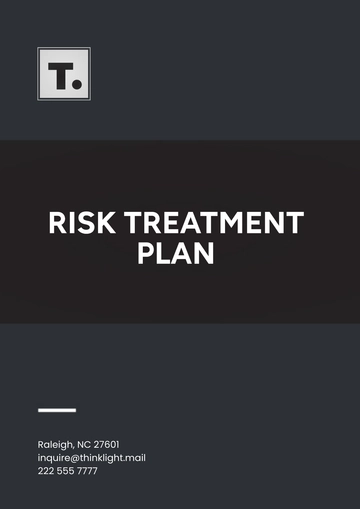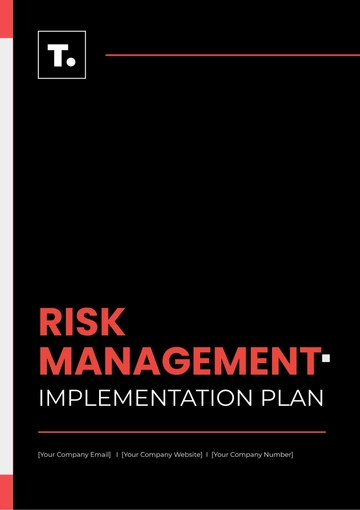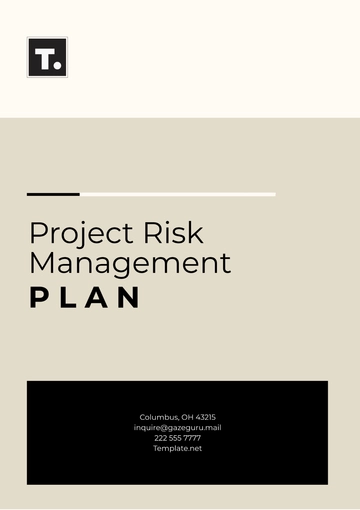Free Board of Director Risk Management Plan

I. Introduction
A. Purpose of the Plan
This Board of Director Risk Management Plan outlines the strategic framework to identify, assess, and mitigate risks that could impact [Your Company Name]’s operations, reputation, and long-term success. It ensures that the Board of Directors has a comprehensive understanding of the company’s risk landscape and is equipped to oversee its risk management activities effectively. The plan is designed to align with the company’s overall strategic goals and regulatory requirements, promoting a culture of proactive risk management.
B. Importance of Risk Management for Board Oversight
Effective risk management is essential for safeguarding the company’s assets, maintaining stakeholder trust, and ensuring business continuity. As the governing body, the Board of Directors must oversee the company’s approach to risk management and make informed decisions that enhance long-term value. The Board is responsible for ensuring that the organization’s risk profile aligns with its risk appetite and that all material risks are addressed appropriately.
C. Scope of the Plan
This plan applies to all aspects of risk management within [Your Company Name], including financial, operational, strategic, reputational, and regulatory risks. It encompasses risk identification, assessment, mitigation, monitoring, and reporting. The scope also includes crisis management, business continuity, and compliance with all applicable laws and regulations.
D. Overview of the Organization’s Risk Management Framework
[Your Company Name] employs a comprehensive, enterprise-wide risk management framework that incorporates best practices, industry standards, and regulatory requirements. The framework includes structured risk assessments, defined roles and responsibilities, and robust monitoring and reporting systems. This ensures that risks are effectively identified and managed across all levels of the organization.
II. Risk Management Governance Structure
A. Roles and Responsibilities of the Board
The Board of Directors is ultimately responsible for overseeing risk management within [Your Company Name]. It ensures that risk management strategies are integrated into the company’s overall strategic planning process and are aligned with its business objectives. The Board monitors risk mitigation efforts and ensures that adequate resources are allocated for risk management activities, both at the operational and strategic levels.
B. Risk Management Committee
The Risk Management Committee, composed of independent Board members with relevant expertise, is tasked with providing guidance and oversight of the risk management process. The committee meets quarterly to review risk reports, assess the effectiveness of the risk management framework, and recommend actions to address emerging risks. The committee reports its findings and recommendations directly to the full Board.
C. Chief Risk Officer’s (CRO) Role and Authority
The Chief Risk Officer (CRO) leads the development, implementation, and continuous improvement of the risk management framework. The CRO reports directly to the Board and the Risk Management Committee, providing regular updates on risk status, emerging threats, and mitigation strategies. The CRO has the authority to collaborate across departments to ensure that risk management practices are followed throughout the organization.
D. Internal Audit and Compliance Oversight
The internal audit function works closely with the CRO to identify gaps in risk controls and ensure compliance with established risk management procedures. Additionally, the compliance team monitors regulatory changes and assesses the impact of new laws and policies on the company’s risk profile. Both functions provide the Board with independent assurances regarding the company’s risk management processes.
III. Risk Identification and Assessment
A. Overview of Risk Identification Process
Risk identification is a continuous process that involves systematic efforts to identify both internal and external risks that may affect the company’s objectives. This includes conducting regular risk workshops, utilizing risk registers, and analyzing market trends. All relevant departments contribute to identifying risks based on their expertise and operational focus.
B. Risk Assessment Methodology
Risks are assessed based on their potential impact and likelihood, using a combination of qualitative and quantitative measures. The company uses a risk matrix to categorize risks according to their severity and probability, with high-priority risks receiving the most attention. A key component of this process is defining the company’s risk appetite and ensuring that identified risks are aligned with it.
C. Tools and Techniques for Risk Identification
To support effective risk identification, [Your Company Name] employs a variety of tools, including risk assessments, scenario analysis, and stress testing. These tools allow the company to model different risk scenarios and evaluate their potential impacts on the business. Regular workshops are also held with senior management and key stakeholders to ensure that new risks are identified promptly.
IV. Risk Mitigation and Control Measures
A. Risk Treatment Strategies
For each identified risk, [Your Company Name] develops and implements a treatment strategy. Strategies may include risk avoidance, reduction, transfer, or acceptance, depending on the nature of the risk. For example, financial risks may be mitigated through hedging strategies, while operational risks may be reduced by improving internal controls and processes.
B. Risk Mitigation Plans for Critical Risks
The company prioritizes its critical risks, focusing on those with the highest potential impact on business continuity. Each critical risk is assigned to a responsible department, with clear action plans to address and mitigate it. These action plans include specific risk-reduction measures, timelines, and resource allocations.
C. Implementation of Risk Controls and Monitoring Systems
[Your Company Name] implements a set of key risk controls, including regular monitoring of financial, operational, and strategic risks. Key Performance Indicators (KPIs) are established to track risk mitigation efforts, and regular reporting ensures that the Board is kept informed about risk status. The company also uses automated monitoring systems to identify changes in risk conditions in real time.
V. Crisis Management and Business Continuity Planning
A. Crisis Management Framework
The crisis management framework is designed to ensure a coordinated response to significant, unforeseen events that could disrupt business operations. The company has established a Crisis Management Team, led by the CEO, to manage crisis situations. Emergency protocols and communication strategies are in place to ensure quick and efficient responses to any crisis.
B. Business Continuity and Disaster Recovery Plans
[Your Company Name] has developed comprehensive business continuity and disaster recovery plans to ensure that essential functions can continue during a crisis. These plans include detailed procedures for recovering IT systems, restoring operations, and maintaining customer service. Regular tests and simulations are conducted to ensure the effectiveness of these plans.
C. Testing and Drills for Crisis Situations
To ensure preparedness, the company conducts annual crisis management drills, involving all key stakeholders. These simulations test the effectiveness of the crisis response and business continuity plans, identifying areas for improvement. The results of each drill are reviewed by the Risk Management Committee and used to enhance the company’s readiness for actual crises.
VI. Risk Monitoring and Reporting
A. Ongoing Risk Monitoring Processes
Risk monitoring is an ongoing process at [Your Company Name], with regular reviews of identified risks and the effectiveness of mitigation strategies. The company utilizes a real-time risk dashboard to monitor key risks and indicators. Senior management is responsible for ensuring that risks are actively monitored and that necessary adjustments are made.
B. Reporting Structure to the Board
The Risk Management Committee provides the Board with quarterly reports on the company’s risk landscape, including updates on the status of mitigation efforts. These reports highlight new risks, changes in risk exposure, and recommendations for Board action. The CRO also presents an annual risk assessment to ensure that the Board has a comprehensive understanding of the company’s risk profile.
C. Continuous Improvement Process
The company’s risk management processes are subject to continuous improvement, with regular reviews to incorporate lessons learned from past incidents and emerging best practices. The Board reviews the effectiveness of the risk management plan annually and approves updates as necessary to ensure its alignment with organizational goals and the external environment.
VII. Compliance and Legal Considerations
A. Adherence to Legal and Regulatory Requirements
[Your Company Name] ensures strict adherence to all relevant local, national, and international regulations governing risk management practices. Legal and regulatory risks are regularly reviewed to ensure compliance with the latest standards, including environmental regulations, financial reporting standards, and data protection laws. The company maintains a compliance framework to ensure all departments understand and adhere to legal requirements.
Regulatory Area | Regulation/Standard | Compliance Status | Review Frequency |
|---|---|---|---|
Financial Reporting | IFRS (International Financial Reporting Standards) | Fully Compliant | Quarterly |
Data Protection | GDPR (General Data Protection Regulation) | Fully Compliant | Annually |
Environmental Standards | ISO 14001 (Environmental Management) | In Progress | Annually |
Labor Laws | Fair Labor Standards Act (FLSA | Fully Compliant | Semi-Annually |
B. Ethical Risk Management Practices
At [Your Company Name], ethical decision-making is embedded in every level of operations. The company’s Code of Ethics governs all business conduct and risk management decisions. In addition to regulatory compliance, the company fosters a culture of integrity, transparency, and accountability, ensuring that ethical risks, including conflicts of interest and fraud, are mitigated through internal controls and training.
VIII. Training and Awareness
A. Board and Executive Training on Risk Management
To ensure that the Board and executives remain informed and capable of overseeing the company’s risk management processes, annual training sessions are conducted. These training sessions cover emerging risk trends, regulatory changes, and advanced risk management techniques. Board members are also encouraged to attend industry conferences and workshops related to risk management.
Training Topic | Training Provider | Training Frequency | Next Scheduled Session |
|---|---|---|---|
Emerging Risk Trends | External Risk Consultant | Annually | Q3 2051 |
Advanced Risk Management Techniques | Internal Risk Management Team | Semi-Annually | Q2 2051 |
Regulatory Changes (e.g., GDPR) | Legal and Compliance Team | Annually | Q4 2051 |
B. Ongoing Risk Management Education
The company provides continuous education on risk management for all employees. Regular updates on emerging risks, such as cybersecurity threats or environmental regulations, are disseminated through newsletters, intranet posts, and departmental meetings. This ensures that all levels of the organization are aware of potential risks and are prepared to act accordingly.
C. Best Practices in Risk Management
To maintain high standards in risk management, the company regularly benchmarks its practices against industry best practices. This ensures the company remains competitive in managing risks effectively and remains compliant with evolving risk management standards. The company actively participates in industry forums and consults with external risk experts to integrate cutting-edge practices into its risk management processes.
IX. Risk Culture and Communication
A. Promoting a Risk-Aware Culture Across the Organization
[Your Company Name] is committed to fostering a risk-aware culture where all employees are encouraged to identify and report potential risks. Through leadership initiatives and clear communication from the Board, the company promotes an open dialogue about risks at every level of the organization. This helps ensure that risk management is not only the responsibility of the Board or senior management but is embedded in the company’s day-to-day operations.
Risk Awareness Initiative | Description | Target Audience | Timeline |
|---|---|---|---|
Risk Awareness Workshops | Workshops to educate staff on identifying risks | All Employees | Quarterly |
Monthly Risk Management Newsletters | Regular updates on emerging risks and mitigation | Management and Staff | Monthly |
Leadership Risk Culture Sessions | Sessions on building a risk-aware leadership culture | Senior Leadership Team | Bi-Annually |
B. Communication Strategy for Risk Management
The communication strategy for risk management is centered around transparency and timely information sharing. Internally, risk reports and updates are communicated via email, meetings, and the intranet. Externally, key stakeholders, including shareholders and regulators, receive periodic reports and updates on the company’s risk management performance.
X. Conclusion
A. Summary of the Risk Management Plan
This comprehensive Risk Management Plan provides the Board of Directors with the necessary tools, processes, and frameworks to identify, assess, and mitigate risks effectively. The plan establishes clear governance structures, identifies key roles and responsibilities, and outlines how risks will be monitored and managed across the organization. Through continuous training, communication, and a commitment to best practices, [Your Company Name] ensures it is well-positioned to navigate risks in an ever-changing business environment.
B. Commitment to Ongoing Risk Oversight and Continuous Improvement
[Your Company Name] is committed to continuously improving its risk management processes to ensure they evolve with emerging risks and industry standards. The company values the ongoing commitment of the Board, senior management, and all employees to fostering a risk-aware culture and responding to risks promptly and effectively.
C. Review and Approval Process for the Plan
The Board of Directors will review this Risk Management Plan annually to ensure it remains relevant and effective. The Risk Management Committee will provide input and recommendations for updates, and any significant changes will be presented for approval by the full Board. Regular reviews ensure that the plan continues to reflect the evolving risk landscape and organizational priorities.
- 100% Customizable, free editor
- Access 1 Million+ Templates, photo’s & graphics
- Download or share as a template
- Click and replace photos, graphics, text, backgrounds
- Resize, crop, AI write & more
- Access advanced editor
Organize your company’s risk management strategy with the Board of Director Risk Management Plan Template from Template.net. This editable and customizable template allows you to tailor your risk management plan to your organization’s unique needs. Enhance efficiency with the integrated AI Editor Tool, making it easier than ever to create a comprehensive and professional plan.
You may also like
- Finance Plan
- Construction Plan
- Sales Plan
- Development Plan
- Career Plan
- Budget Plan
- HR Plan
- Education Plan
- Transition Plan
- Work Plan
- Training Plan
- Communication Plan
- Operation Plan
- Health And Safety Plan
- Strategy Plan
- Professional Development Plan
- Advertising Plan
- Risk Management Plan
- Restaurant Plan
- School Plan
- Nursing Home Patient Care Plan
- Nursing Care Plan
- Plan Event
- Startup Plan
- Social Media Plan
- Staffing Plan
- Annual Plan
- Content Plan
- Payment Plan
- Implementation Plan
- Hotel Plan
- Workout Plan
- Accounting Plan
- Campaign Plan
- Essay Plan
- 30 60 90 Day Plan
- Research Plan
- Recruitment Plan
- 90 Day Plan
- Quarterly Plan
- Emergency Plan
- 5 Year Plan
- Gym Plan
- Personal Plan
- IT and Software Plan
- Treatment Plan
- Real Estate Plan
- Law Firm Plan
- Healthcare Plan
- Improvement Plan
- Media Plan
- 5 Year Business Plan
- Learning Plan
- Marketing Campaign Plan
- Travel Agency Plan
- Cleaning Services Plan
- Interior Design Plan
- Performance Plan
- PR Plan
- Birth Plan
- Life Plan
- SEO Plan
- Disaster Recovery Plan
- Continuity Plan
- Launch Plan
- Legal Plan
- Behavior Plan
- Performance Improvement Plan
- Salon Plan
- Security Plan
- Security Management Plan
- Employee Development Plan
- Quality Plan
- Service Improvement Plan
- Growth Plan
- Incident Response Plan
- Basketball Plan
- Emergency Action Plan
- Product Launch Plan
- Spa Plan
- Employee Training Plan
- Data Analysis Plan
- Employee Action Plan
- Territory Plan
- Audit Plan
- Classroom Plan
- Activity Plan
- Parenting Plan
- Care Plan
- Project Execution Plan
- Exercise Plan
- Internship Plan
- Software Development Plan
- Continuous Improvement Plan
- Leave Plan
- 90 Day Sales Plan
- Advertising Agency Plan
- Employee Transition Plan
- Smart Action Plan
- Workplace Safety Plan
- Behavior Change Plan
- Contingency Plan
- Continuity of Operations Plan
- Health Plan
- Quality Control Plan
- Self Plan
- Sports Development Plan
- Change Management Plan
- Ecommerce Plan
- Personal Financial Plan
- Process Improvement Plan
- 30-60-90 Day Sales Plan
- Crisis Management Plan
- Engagement Plan
- Execution Plan
- Pandemic Plan
- Quality Assurance Plan
- Service Continuity Plan
- Agile Project Plan
- Fundraising Plan
- Job Transition Plan
- Asset Maintenance Plan
- Maintenance Plan
- Software Test Plan
- Staff Training and Development Plan
- 3 Year Plan
- Brand Activation Plan
- Release Plan
- Resource Plan
- Risk Mitigation Plan
- Teacher Plan
- 30 60 90 Day Plan for New Manager
- Food Safety Plan
- Food Truck Plan
- Hiring Plan
- Quality Management Plan
- Wellness Plan
- Behavior Intervention Plan
- Bonus Plan
- Investment Plan
- Maternity Leave Plan
- Pandemic Response Plan
- Succession Planning
- Coaching Plan
- Configuration Management Plan
- Remote Work Plan
- Self Care Plan
- Teaching Plan
- 100-Day Plan
- HACCP Plan
- Student Plan
- Sustainability Plan
- 30 60 90 Day Plan for Interview
- Access Plan
- Site Specific Safety Plan





























